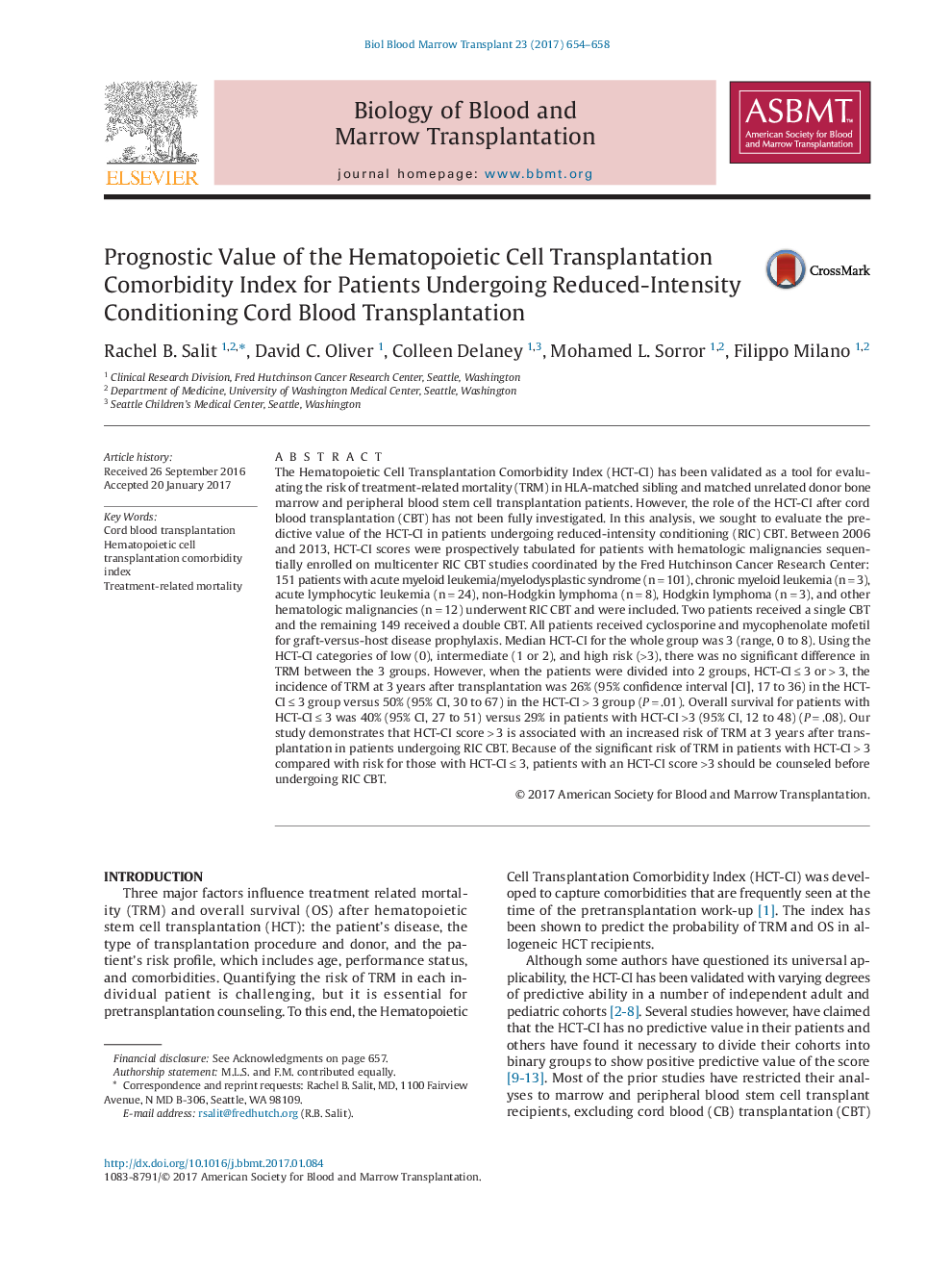| Article ID | Journal | Published Year | Pages | File Type |
|---|---|---|---|---|
| 5524422 | Biology of Blood and Marrow Transplantation | 2017 | 5 Pages |
â¢Similar to what has been seen with HLA-matched sibling and matched unrelated donor bone marrow and peripheral blood stem cell transplantation, the Hematopoietic Cell Transplantation Comorbidity Index score is a good predictor of treatment-related mortality in reduced-intensity cord blood transplantationâ¢Patients undergoing reduced-intensity conditioning cord blood transplantation with a Hematopoietic Cell Transplantation Comorbidity Index scoreâ>â3 had a significantly increased risk of treatment-related mortality at 100 days and 1 year and 3 years after transplantation, when compared with patients who had a score ofââ¤â3â¢When controlling for gender, age at transplantation, Karnofsky performance status, race, cytomegalovirus serostatus, disease type, disease risk, and conditioning regimen, in multivariate analysis, Hematopoietic Cell Transplantation Comorbidity Index score ofâ>â3 only (hazard ratio, 2.12; 95% confidence interval, 1.11 to 4.01; Pâ=â.02) was significantly associated with higher risk of treatment-related mortality at 3 years
The Hematopoietic Cell Transplantation Comorbidity Index (HCT-CI) has been validated as a tool for evaluating the risk of treatment-related mortality (TRM) in HLA-matched sibling and matched unrelated donor bone marrow and peripheral blood stem cell transplantation patients. However, the role of the HCT-CI after cord blood transplantation (CBT) has not been fully investigated. In this analysis, we sought to evaluate the predictive value of the HCT-CI in patients undergoing reduced-intensity conditioning (RIC) CBT. Between 2006 and 2013, HCT-CI scores were prospectively tabulated for patients with hematologic malignancies sequentially enrolled on multicenter RIC CBT studies coordinated by the Fred Hutchinson Cancer Research Center: 151 patients with acute myeloid leukemia/myelodysplastic syndrome (nâ=â101), chronic myeloid leukemia (nâ=â3), acute lymphocytic leukemia (nâ=â24), non-Hodgkin lymphoma (nâ=â8), Hodgkin lymphoma (nâ=â3), and other hematologic malignancies (nâ=â12) underwent RIC CBT and were included. Two patients received a single CBT and the remaining 149 received a double CBT. All patients received cyclosporine and mycophenolate mofetil for graft-versus-host disease prophylaxis. Median HCT-CI for the whole group was 3 (range, 0 to 8). Using the HCT-CI categories of low (0), intermediate (1 or 2), and high risk (>3), there was no significant difference in TRM between the 3 groups. However, when the patients were divided into 2 groups, HCT-CIââ¤â3 orâ>â3, the incidence of TRM at 3 years after transplantation was 26% (95% confidence interval [CI], 17 to 36) in the HCT-CIââ¤â3 group versus 50% (95% CI, 30 to 67) in the HCT-CIâ>â3 group (Pâ=â.01). Overall survival for patients with HCT-CIââ¤â3 was 40% (95% CI, 27 to 51) versus 29% in patients with HCT-CI >3 (95% CI, 12 to 48) (Pâ=â.08). Our study demonstrates that HCT-CI scoreâ>â3 is associated with an increased risk of TRM at 3 years after transplantation in patients undergoing RIC CBT. Because of the significant risk of TRM in patients with HCT-CIâ>â3 compared with risk for those with HCT-CIââ¤â3, patients with an HCT-CI score >3 should be counseled before undergoing RIC CBT.
